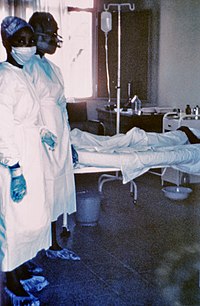
Photo from wikipedia
Abstract Background By the end of the third wave of the coronavirus disease 2019 (COVID-19) epidemic (May–October 2021), only 3130 of the 57 268 confirmed cases of coronavirus disease 2019… Click to show full abstract
Abstract Background By the end of the third wave of the coronavirus disease 2019 (COVID-19) epidemic (May–October 2021), only 3130 of the 57 268 confirmed cases of coronavirus disease 2019 (COVID-19) in the Democratic Republic of the Congo (DRC) were reported in Kongo Central. This province, and especially its capital city, Matadi, has essential trade and exchanges with Kinshasa, the epicenter of the COVID-19 epidemic in DRC. Kinshasa accounted for 60.0% of all cases during the same period. The true burden of COVID-19 in Matadi is likely underestimated. In this study, we aimed to determine the severe acute respiratory syndrome coronavirus 2 (SARS-CoV-2) seroprevalence and associated risk factors after the third wave in Matadi. Methods We conducted a population-based cross-sectional study in October 2021. Consenting participants were interviewed and tested using an enzyme-linked immunosorbent assay commercial kit. We applied univariable and multivariable analysis to evaluate factors associated with seropositivity and adjusted the seroprevalence for the test kit performance. Results We included 2210 participants from 489 households. Female participants represented 59.1%. The median age was 27 years (interquartile range, 16–45 years). The crude SARS-CoV-2 seroprevalence was 82.3%. Age was identified as the main risk factor as younger age decreased the seropositivity odds. Accounting for clustering at the household level increased the seroprevalence to 83.2%. The seroprevalence increased further to 88.1% (95% confidence interval, 86.2%–90.1%) after correcting for the laboratory test kit performance. Conclusions The SARS-CoV-2 seroprevalence was very high, contrasting with reported cases. Evidence generated from this population-based survey remains relevant in guiding the local COVID-19 response, especially vaccination strategies.
Journal Title: Open Forum Infectious Diseases
Year Published: 2023
Link to full text (if available)
Share on Social Media: Sign Up to like & get
recommendations!